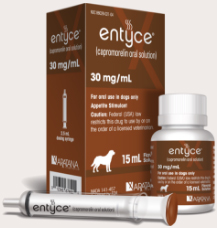| There’s an FDA-approved option for stimulating appetite in dogs |
|
|

|
|
|
| When a dog is living with a chronic medical condition, any small change in behavior can be emotionally distressing for their family. Pet owners often associate their dog’s eating with quality of life. When appetite is reduced, they fear the dog is suffering. |
|
|
|
|
|
|
|
|
| In the short video, “Appetite and Quality of Life: A Pet Owner’s Perspective,” Natalie Marks, DVM, introduces us to a client who shares what it means to see her dog eating and active while living with cancer. |
|
|
|
|
|
|
|
|
|
|
|
| Clients like to see their dog eating. Here’s how to stimulate appetite. |
|
|
| At the first signs of reduced appetite, add ENTYCE® (capromorelin oral solution) as part of your overall treatment plan. |
|
|
|

|
|
|
|
| • |
Proven safe for long-term use1 |
|
 |
| • |
Effectively stimulates appetite to help improve food consumption |
|
 |
| • |
The ONLY FDA-approved appetite stimulant for dogs |
|
|
|
|
|
|
 |
| 1 Zollers B, Huebner M, Armintrout G, Rausch-Derra LC, Rhodes L. Evaluation of the safety in dogs of long-term, daily oral administration of capromorelin, a novel drug for stimulation of appetite. J Vet Pharmacol Ther. 2017 Jun;40(3):248-255. |
 |
| IMPORTANT SAFETY INFORMATION: ENTYCE® (capromorelin oral solution) is for use in dogs only. Do not use in breeding, pregnant or lactating dogs. Use with caution in dogs with hepatic dysfunction or renal insufficiency. Adverse reactions in dogs may include diarrhea, vomiting, polydipsia, and hypersalivation. Should not be used in dogs that have a hypersensitivity to capromorelin. Please see the full Prescribing Information for more detail. |
 |
|
|
|
|
|
|
|
|
|
|

